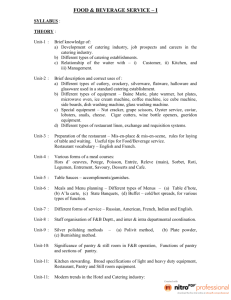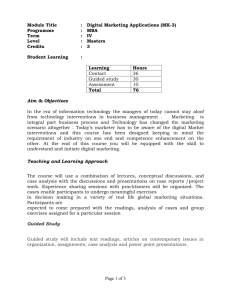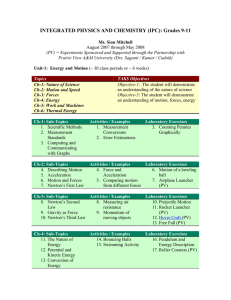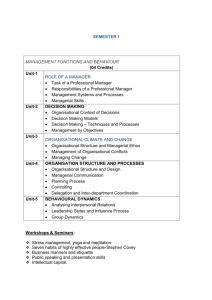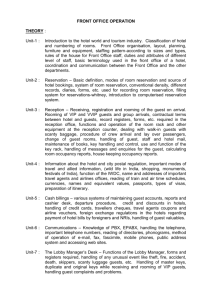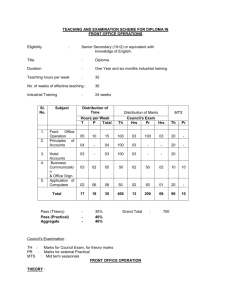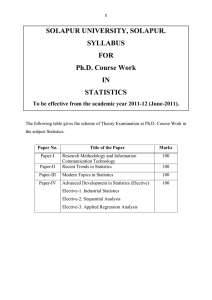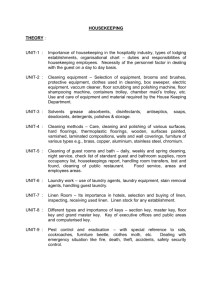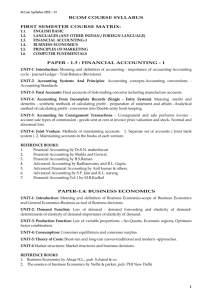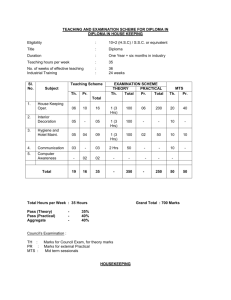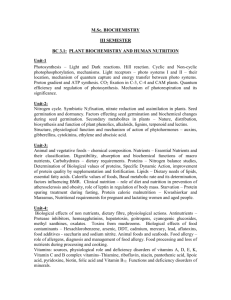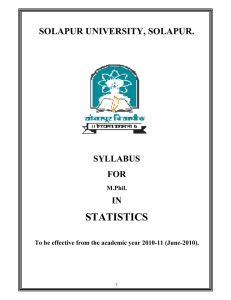Syllabus Diploma in Food Beverage Service
advertisement
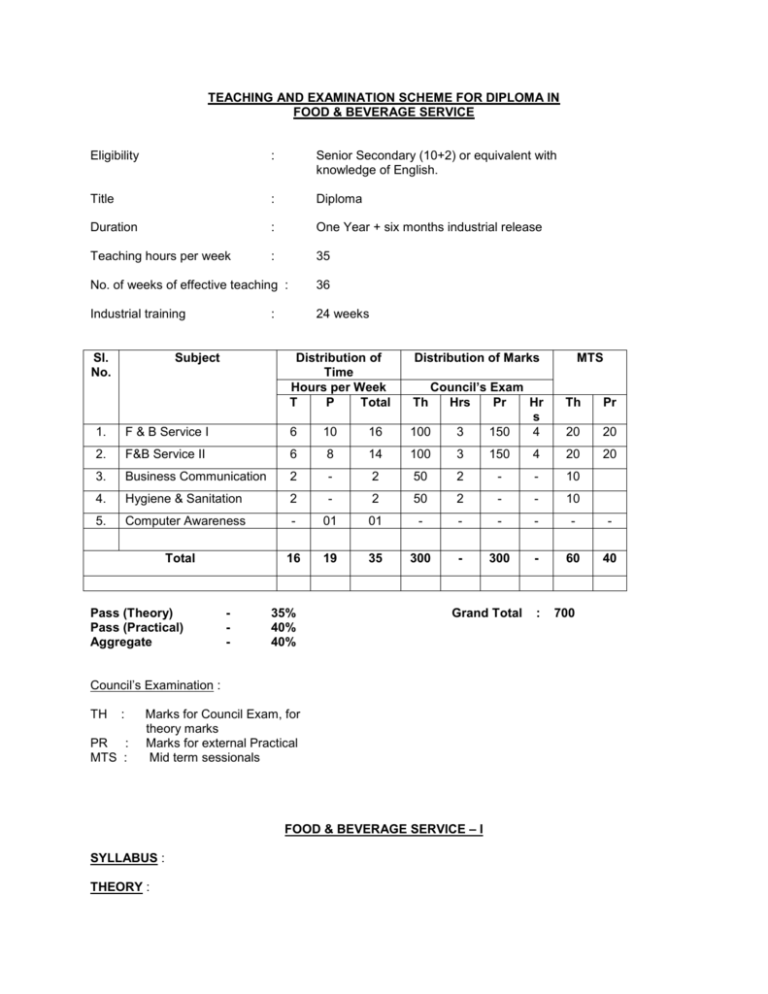
TEACHING AND EXAMINATION SCHEME FOR DIPLOMA IN FOOD & BEVERAGE SERVICE Eligibility : Senior Secondary (10+2) or equivalent with knowledge of English. Title : Diploma Duration : One Year + six months industrial release Teaching hours per week : 35 No. of weeks of effective teaching : 36 Industrial training 24 weeks Sl. No. : Subject Distribution of Time Hours per Week T P Total Distribution of Marks MTS 1. F & B Service I 6 10 16 Council’s Exam Hrs Pr Hr s 100 3 150 4 2. F&B Service II 6 8 14 100 3 150 4 20 3. Business Communication 2 - 2 50 2 - - 10 4. Hygiene & Sanitation 2 - 2 50 2 - - 10 5. Computer Awareness - 01 01 - - - - - - 16 19 35 300 - 300 - 60 40 Total Pass (Theory) Pass (Practical) Aggregate - 35% 40% 40% Th Grand Total Council’s Examination : TH : PR : MTS : Marks for Council Exam, for theory marks Marks for external Practical Mid term sessionals FOOD & BEVERAGE SERVICE – I SYLLABUS : THEORY : : Th Pr 20 20 20 700 Unit-1 : Brief knowledge of: a) Development of catering industry, job prospects and careers in the catering industry. b) Different types of catering establishments. c) Relationship of the waiter with – i) Customer, ii) Kitchen, and iii) Management. Unit-2 : Brief description and correct uses of : a) Different types of cutlery, crockery, silverware, flatware, halloware and glassware used in a standard catering establishment. b) Different types of equipment – Baine Marie, plate warmer, hot plates, microwave oven, ice cream machine, coffee machine, ice cube machine, side boards, dish washing machine, glass washing machine. c) Special equipment – Nut cracker, grape scissors, Oyster service, caviar, lobsters, snails, cheese. Cigar cutters, wine bottle openers, gueridon equipment. d) Different types of restaurant linen, exchange and requisition systems. Unit-3 : Preparation of the restaurant – Mis-en-place & mis-en-scene, rules for laying of table and waiting. Useful tips for Food/Beverage service. Restaurant vocabulary – English and French. Unit-4 : Various forms of a meal courses: Hors d’ oeuvres, Potege, Poisson, Entrée, Releve (main), Sorbet, Roti, Legumen, Entrement, Savoury, Desserts and Cafe. Unit-5 : Table Sauces – accompliments/garnishes. Unit-6 : Meals and Menu planning – Different types of Menus – (a) Table d’hote, (b) A’la carte, (c) State Banquets, (d) Buffet – cold/hot spreads, for various types of function. Unit-7 : Different forms of service – Russian, American, French, Indian and English. Unit-8 : Staff organisation of F&B Deptt., and inter & intra departmental coordination. Unit-9 : Silver polishing methods – (a) Polivit method, (b) Plate powder, method. (c) Burnishing Unit-10: Significance of pantry & still room in F&B operation, Functions of pantry and sections of pantry. Unit-11: Kitchen stewarding. Broad specifications of light and heavy duty equipment, Restaurant, Pantry and Still room equipment. Unit-11: Modern trends in the Hotel and Catering industry: - Ecotels - Fast Food outlets - Adventure Tourism - Theme Restaurants - Welfare Catering PRACTICALS : Hygienic handling of cutlery, crockery, glassware and trays. Laying and relaying of table cloth during and before meals. Correct use of waiter’s cloth runners, Napkins and Napkin foldings. Mise-en-scene and Mise-en-place for various types of meals and menus. Correct handling and practice of service spoons and service forks, silver service. Serving and clearing of a meal (course by course). Table d’hote menus, laying for cover and service for lunch and dinner, preparation & service of tea, black coffee, turkish coffee, cona coffee, espresso coffee. Receiving and seating the guests, presenting menu cards and taking the order from guests and writing of KOT. Passing the order to the Kitchen & pickup. Making and presentation of a bill. Organising parties and functions – Buffets & Banquets. Indian and Chinese food service procedures. Daily briefing and system of tips/distribution. FOOD & BEVERAGE SERVICE – II THEORY : Simple methods of restaurant sales, controls – K.O.T flow and billing. Computerized order taking and billing. Breakfast - English, American, Continental and Indian Breakfast (laying & service). Ice creams / Sundaes / Shakes - Different types and their service. Knowledge - Buffet, Layout, Display & Service. Banquets, inquiry forms, sitting space, seating arrangements, service formalities, toast procedures. Room Service - Centralised and decentralised – Room service of breakfast, snacks, lunch, dinner; Beverages - alcoholic or non-alcoholic. Room Service flow chart. Wine - Definition, making and classifications of wines, wine quality and labeling. Wine trade terms – main wine producing countries, wine brand names. Service of red, white and sparkling wines, fortified wines, Aperitifs. Spirits Liqueurs Cocktails Beer - Whiskey, rum, brandy, gin, vodka and their famous brands. Different types with their predominant flavourings and famous ten brands. Classification, rules of making cocktail and recipe of 50 cocktails. Manufacture, service, storage types and brands of beer. Bar lay out, operation and licensing. Dispensing of spirits. Storage of alcoholic beverages and cellar management. Tabaeco-cigars, cigarettes and its brand and strength. PRACTICALS : Service and accompaniments of special dishes - smoked salmon, caviar, asparagus, grape fruit, artichoke, melon, cheese, fresh fruits. Service of breakfast – English, Continental and Indian. (for Restaurant/Room Service) Service of hot beverages – Tea, Coffee & Coco. Pantry and Still room operation. Layout and service of small tea parties and buffets. Laying and service of banquets. Wine service – Taking the order, presenting the bottle, opening of cork and service of red, rose, white and sparkling wines. Service of spirits – whiskey, rum, gin, brandy and vodka. Service of cocktails and liqueurs. Service of beer. Preparation and service of certain gueridon dishes - Crepe suzette, Banana an Rum, peach flambe, pepper steak, steak diane. Service of cigars and cigarettes. Different types of salad dressings. BUSINESS COMMUNICATION UNIT-1 : Introduction – Definition, objectives, principles of effective communication and the importance of good communication. UNIT-2 : Types of communication – formal, informal, verbal, written, horizontal, vertical. UNIT-3 : Essentials of good business letter and types of letters – Official, D.O. UNIT-4 : Letter writing - Circular, Memo, Notice, U.O. Note, applications Bio-data (C.V.) covering letter, Invitations, Greetings, Apologies. UNIT-5 : Use of telephone, fax, taking telephonic orders, telephone etiquette’s. UNIT-6 : Communication with guest and Body language. HYGIENE & SANITATION Unit-1 : Role of Hygiene in Food Science and Dish washing areas, care of premises and equipment. Unit-2 : Personal hygiene, care of skin, hand and feet. Food handlers hygiene, protective clothing. Unit-3 : Dishwashing methods – manual and machine dish washing – merits and demerits. Unit-4 : Garbage disposal – different methods –advantage and disadvantages. Unit-5 : Food Poisoning – Causative factors and the precautions to be taken by food handlers. Unit-6 : Food Storage – Techniques of correct storage, storage temperature of different commodities to prevent bacterial manifestation or contamination. Unit-7 : Pest Control - Rodents and insect control techniques, special stress on control of flies, rats and cockroaches. Unit-8 : Municipal health laws. Unit-9 : Golden rules of first aid and treatment for cuts, wounds, burns. Computer Awareness (to be taught in practical classes) Unit-1 : Computer fundamentals: Information concepts and processing Climents of a computer processing system Hardware, features and uses Input/Output devices Software concepts Unit-2 : Application of computers with reference to hotel operations, processing of table orders and computerized billing. *****
